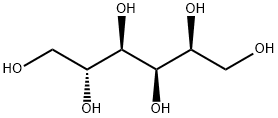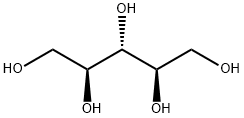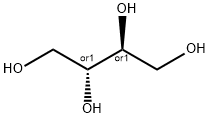Sorbitol
Synonym(s):D -Glucitol;D -Sorbitol;D-Glucitol;Parteck Sorbitol
- CAS NO.:50-70-4
- Empirical Formula: C6H14O6
- Molecular Weight: 182.17
- MDL number: MFCD00004708
- EINECS: 200-061-5
- SAFETY DATA SHEET (SDS)
- Update Date: 2025-01-27 09:38:02

What is Sorbitol?
Chemical properties
White or almost white, crystalline powder.
Chemical properties
Sorbitol is D-glucitol. It is a hexahydric alcohol related to mannose
and is isomeric with mannitol.
Sorbitol occurs as an odorless, white or almost colorless,
crystalline, hygroscopic powder. Four crystalline polymorphs and
one amorphous form of sorbitol have been identified that have
slightly different physical properties, e.g. melting point. Sorbitol is
available in a wide range of grades and polymorphic forms, such as
granules, flakes, or pellets that tend to cake less than the powdered
form and have more desirable compression characteristics. Sorbitol
has a pleasant, cooling, sweet taste and has approximately 50–60%
of the sweetness of sucrose.
Chemical properties
d-Sorbitol has a sweet taste. In comparison to sucrose, the relative sweetness of sorbitol is approximately 50%. Sorbitol can exist in any of several crystalline forms with melting points ranging from 89 to 101°C. For a detailed description of this compound, refer to Burdock (1997).
Originator
Sorbitol,Memphis Co.
Occurrence
Sorbitol is one of the most widely found sugar alcohols in nature with relatively high concentrations occurring in apples, pears, plums, peaches and apricots. Also reported found in several varieties of berries, seaweed and algae.
The Uses of Sorbitol
Sorbitol is a humectant that is a polyol (polyhydric alcohol) produced by hydrogenation of glucose with good solubility in water and poor solubility in oil. It is approximately 60% as sweet as sugar, and has a caloric value of 2.6 kcal/g. It is highly hygroscopic and has a pleasant, sweet taste. It maintains moistness in shredded coconut, pet foods, and candy. In sugarless frozen desserts, it depresses the freezing point, adds solids, and contributes some sweetness. It is used in low-calorie beverages to provide body and taste. It is used in dietary foods such as sugarless candy, chewing gum, and ice cream. It is also used as a crystallization modifier in soft sugar-based confections.
The Uses of Sorbitol
In manufacture of sorbose, ascorbic acid, propylene glycol, synthetic plasticizers and resins; as humectant (moisture conditioner) on printing rolls, in leather, tobacco. In writing inks to insure a smooth flow and to prevent crusting on the point of the pen. In antifreeze mixtures with glycerol or glycols. In candy manufacture of to increase shelf life by retarding the solidification of sugar; as humectant and softener in shredded coconut and peanut butter; as texturizer in foods; as sequestrant in soft drinks and wines. Used to reduce the undesirable aftertaste of saccharin in foodstuffs; as sugar substitute for diabetics. Pharmaceutic aid (flavor; tablet excipient); to increase absorption of vitamins and other nutrients in pharmaceutical preparations: Chem. Eng. News 36, 59 (Feb. 24, 1958).
The Uses of Sorbitol
D-Sorbitol is a sugar alcohol that is naturally found in Toyon berries. D-Sorbitol is used to increase stability of silver nanoparticles and is also used as a sugar substitute.
Background
A polyhydric alcohol with about half the sweetness of sucrose. Sorbitol occurs naturally and is also produced synthetically from glucose. It was formerly used as a diuretic and may still be used as a laxative and in irrigating solutions for some surgical procedures.
Definition
ChEBI: The D-enantiomer of glucitol (also known as D-sorbitol).
Production Methods
Sorbitol occurs naturally in the ripe berries of many trees and
plants. It was first isolated in 1872 from the berries of the Mountain
Ash (Sorbus americana).
Industrially, sorbitol is prepared by high-pressure hydrogenation
with a copper–chromium or nickel catalyst, or by electrolytic
reduction of glucose and corn syrup. If cane or beet sugars are used
as a source, the disaccharide is hydrolyzed to dextrose and fructose
prior to hydrogenation.
Definition
A hexahydric alcohol that occurs in rose hips and rowan berries. It can be synthesized by the reduction of glucose. Sorbitol is used to make vitamin C (ascorbic acid) and surfactants. It is also used in medicines and as a sweetener (particularly in foods for diabetics). It is an isomer of mannitol.
Definition
A polyhydric alcohol, CH2OH(CHOH)4CH2OH, derived from glucose; it is isomeric with mannitol. It is found in rose hips and rowan berries and is manufactured by the catalytic reduction of glucose with hydrogen. Sorbitol is used as a sweetener (in diabetic foods) and in the manufacture of vitamin C and various cosmetics, foodstuffs, and medicines.
Preparation
Sorbitol is manufactured by hydrogenation of glucose with hydrogen and active nickel catalyst. It is commercially available as 70% syrup or as a pure white powder.
Manufacturing Process
20 ml of a suspension of CTAB-permeabilized cells of Zymomonas mobilis
were mixed with 80 ml of a 4% carrageenan solution and the mixture was
poured into shallow dishes and allowed to rigidify. The rigidified immobilizate
was then divided into 3x3x3 mm cubes, exposed to a solution of 0.3 M KCl
overnight and then divided into batches and exposed to one of the following
treatments:
(A) Cubes stabilized with potassium ions were used without further treatment
for production of sorbitol/gluconic acid.
(B) Cubes were incubated with a 1.0% solution of polyethyleneimine at room
temperature for 30 min and then treated with glutaraldehyde at 4°C for 30
min.
Comparison of two rigidification methods:
A volume of 450 ml of cubes treated by the method described in (A) were
reacted in a 1.5 liter fluidized bed fermenter with a substrate solution
comprised of 100 g/L glucose, 100 g/L fructose and a protein concentration of
6.1 g/L, at a D of 0.053 h-1, and titrated with 3 N KOH. After 48 hours, 68.8%
of the substrate was converted with a resulting production of 3.65 g
sorbitol/L*h and 0.6 g sorbitol/g protein*h. After approximately 50 days, the
productivity of the fermenter was reduced by about one half.
Cubes treated as described (B) using glutaraldehyde at a concentration of
0.5%, were reacted in a 1.6 liter fermenter with a substrate solution
comprised of 100 g/L glucose, 100 g/L fructose and a protein concentration of
8.6 g/L, at a D of 0.055 h-1, and titrated with 3 N KOH. After 48 hours, 90.0%
of the substrate was converted with a resulting production of 4.95 g
sorbitol/L*h and 0 58 g sorbitol/g protein*h. After 75 days, the productivity of
the fermenter was reduced by only 3.5%.
brand name
Sorbo (ICI Americas).
Therapeutic Function
Cholecystokinetic, Diuretic, Pharmaceutic aid
General Description
Odorless colorless solid. Sinks and mixes with water.
Air & Water Reactions
Water soluble.
Reactivity Profile
D-Sorbitol is an alcohol. Flammable and/or toxic gases are generated by the combination of alcohols with alkali metals, nitrides, and strong reducing agents. They react with oxoacids and carboxylic acids to form esters plus water. Oxidizing agents convert them to aldehydes or ketones. Alcohols exhibit both weak acid and weak base behavior. They may initiate the polymerization of isocyanates and epoxides.
Health Hazard
Hot liquid will burn skin.
Pharmaceutical Applications
Sorbitol is widely used as an excipient in pharmaceutical formulations.
It is also used extensively in cosmetics and food products.
Sorbitol is used as a diluent in tablet formulations prepared by
either wet granulation or direct compression. It is particularly
useful in chewable tablets owing to its pleasant, sweet taste and
cooling sensation. In capsule formulations it is used as a plasticizer
for gelatin. Sorbitol has been used as a plasticizer in film
formulations.
In liquid preparations sorbitol is used as a vehicle in sugar-free
formulations and as a stabilizer for drug, vitamin, and
antacid suspensions. Furthermore, sorbitol is used as an excipient in
liquid parenteral biologic formulations to provide effective protein
stabilization in the liquid state. It has also been shown to be a
suitable carrier to enhance the in vitro dissolution rate of
indometacin. In syrups it is effective in preventing crystallization
around the cap of bottles. Sorbitol is additionally used in
injectable and topical preparations, and therapeutically as an
osmotic laxative.
Sorbitol may also be used analytically as a marker for assessing
liver blood flow.
Biochem/physiol Actions
D-Sorbitol is a sugar alcohol that is commonly used as a sugar substitute. It occurs naturally and is also produced synthetically from glucose. The food industry uses D-sorbitol as an additive in the form of a sweetener, humectant, emulsifier, thickener, or dietary supplement. D-Sorbitol has also been found in cosmetics, paper, and pharmaceuticals. Naturally, D-sorbitol occurs widely in plants via photosynthesis, ranging from algae to higher order fruits of the family Rosaceae.
Safety Profile
Mildly toxic by ingestion. Human systemic effects by ingestion: hypermotility and diarrhea. Mutation data reported. When heated to decomposition it emits acrid smoke and irritating fumes.
Safety
Sorbitol is widely used in a number of pharmaceutical products and
occurs naturally in many edible fruits and berries. It is absorbed
more slowly from the gastrointestinal tract than sucrose and is
metabolized in the liver to fructose and glucose. Its caloric value is
approximately 16.7 J/g (4 cal/g). Sorbitol is better tolerated by diabetics than sucrose and is widely used in many sugar-free liquid
vehicles. However, it is not considered to be unconditionally safe for
diabetics.
Reports of adverse reactions to sorbitol are largely due to its
action as an osmotic laxative when ingested orally,(17–19) which may
be exploited therapeutically. Ingestion of large quantities of sorbitol
(>20 g/day in adults) should therefore be avoided.
Sorbitol is not readily fermented by oral microorganisms and has
little effect on dental plaque pH; hence, it is generally considered to
be noncariogenic.
Sorbitol is generally considered to be more irritating than
mannitol.
LD50 (mouse, IV): 9.48 g/kg
LD50 (mouse, oral): 17.8 g/kg
LD50 (rat, IV): 7.1 g/kg
LD50 (rat, SC): 29.6 g/kg
Side Effects
There are no formal recommendations for sorbitol intake. Fermentation of sorbitol in the large intestine can create gastrointestinal discomfort including bloating, gas and diarrhea. But these effects are not the same for everyone. Therefore, the FDA requires a label statement regarding potential laxative effects for foods that might lead to eating 50 grams of sorbitol in a day.
For those following a low Fermentable Oligosaccharides Disaccharides Monosaccharides And Polyols (FODMAP) diet, food sources of sorbitol are monitored because sorbitol is a type of polyol.
storage
Sorbitol is chemically relatively inert and is compatible with most
excipients. It is stable in air in the absence of catalysts and in cold,
dilute acids and alkalis. Sorbitol does not darken or decompose at
elevated temperatures or in the presence of amines. It is
nonflammable, noncorrosive, and nonvolatile.
Although sorbitol is resistant to fermentation by many microorganisms,
a preservative should be added to sorbitol solutions.
Solutions may be stored in glass, plastic, aluminum, and stainless
steel containers. Solutions for injection may be sterilized by
autoclaving.
The bulk material is hygroscopic and should be stored in an
airtight container in a cool, dry place.
Purification Methods
Crystallise D(-)-sorbitol (as hemihydrate) several times from EtOH/water (1:1), then dry it by fusing and storing over anhydrous MgSO4. [Koch et al. J Am Chem Soc 75 953 1953, Beilstein 1 IV 2839.]
Incompatibilities
Sorbitol will form water-soluble chelates with many divalent and
trivalent metal ions in strongly acidic and alkaline conditions.
Addition of liquid polyethylene glycols to sorbitol solution, with
vigorous agitation, produces a waxy, water-soluble gel with a
melting point of 35–40℃. Sorbitol solutions also react with iron
oxide to become discolored.
Sorbitol increases the degradation rate of penicillins in neutral
and aqueous solutions.
Regulatory Status
GRAS listed. Accepted for use as a food additive in Europe. Included in the FDA Inactive Ingredients Database (intra-articular and IM injections; nasal; oral capsules, solutions, suspensions, syrups and tablets; rectal, topical, and vaginal preparations). Included in parenteral and nonparenteral medicines licensed in the UK. Included in the Canadian List of Acceptable Non-medicinal Ingredients.
Properties of Sorbitol
| Melting point: | 98-100 °C (lit.) |
| Boiling point: | bp760 105° |
| alpha | 4 º (per eur. pharm.) |
| Density | 1.28 g/mL at 25 °C |
| vapor density | <1 (vs air) |
| vapor pressure | <0.1 mm Hg ( 25 °C) |
| refractive index | n |
| FEMA | 3029 | D-SORBITOL |
| Flash point: | >100°C |
| storage temp. | room temp |
| solubility | Very soluble in water, slightly soluble in ethanol |
| form | liquid |
| pka | pKa (17.5°): 13.6 |
| Specific Gravity | 1.28 |
| color | White |
| Odor | Odorless |
| PH Range | 5 - 7 at 182 g/l at 25 °C |
| PH | 5.0-7.0 (25℃, 1M in H2O) |
| optical activity | [α]20/D 1.5±0.3°, c = 10% in H2O |
| Water Solubility | SOLUBLE |
| Sensitive | Hygroscopic |
| λmax | λ: 260 nm Amax: 0.04 λ: 280 nm Amax: 0.045 |
| Merck | 14,8725 |
| BRN | 1721899 |
| Dielectric constant | 33.5(27℃) |
| Stability: | Stable. Avoid strong oxidizing agents. Protect from moisture. |
| CAS DataBase Reference | 50-70-4(CAS DataBase Reference) |
| NIST Chemistry Reference | Sorbitol(50-70-4) |
| EPA Substance Registry System | Sorbitol (50-70-4) |
Safety information for Sorbitol
| Signal word | Warning |
| Pictogram(s) |
 Exclamation Mark Irritant GHS07 |
| Precautionary Statement Codes |
P261:Avoid breathing dust/fume/gas/mist/vapours/spray. P264:Wash hands thoroughly after handling. P264:Wash skin thouroughly after handling. P270:Do not eat, drink or smoke when using this product. P271:Use only outdoors or in a well-ventilated area. P280:Wear protective gloves/protective clothing/eye protection/face protection. |
Computed Descriptors for Sorbitol
| InChIKey | FBPFZTCFMRRESA-JGWLITMVSA-N |
Sorbitol manufacturer
Benzer Multitech India Pvt Ltd
Gangwal Healthcare Pvt Ltd
Sukhjit Starch And Chemicals Ltd
ARRAKIS INDUSTRIES LLP
New Products
1-Amino-1-cyclohexanecarboxylic acid Cycloleucine 6-Bromo-3-iodo-1-methyl-1H-indazole 3-(2,4-Dimethoxybenzyl)dihydropyrimidine-2,4(1H,3H)-dione 7-Bromo-1H-indazole ELECTROLYTIC IRON POWDER 2-Methyl-2-phenylpropyl acetate 1-Aminocyclobutanecarboxylic acid 1-(2-Ethoxyethyl)-2-(piperidin-4-yl)-1H-benzo[d]imidazole hydrochloride Decanonitrile tert-butyl 4-(1H-benzo[d]iMidazol-2-yl)piperidine-1-carboxylate 4-Ethylbenzylamine Methyl 5-bromo-2-chloro-3-nitrobenzoate N-(5-Amino-2-methylphenyl)acetamide 2-Chloro-3-nitropyridine 5-Bromo-2,3-dimethoxypyridine methyl 6-chloro-2-(chloromethyl)nicotinate 2-methoxy-4-methyl-5-nitro pyridine 2-iodo-5-bromo pyridine 2-amino-4-methyl-5-nitro pyridine 5-Fluoro-2-Oxindole methyl L-alaninate hydrochloride diethyl L-glutamate hydrochloride Ethyl tosylcarbamateRelated products of tetrahydrofuran
You may like
-
 Sorbitol 99%View Details
Sorbitol 99%View Details -
 Sorbitol 99%View Details
Sorbitol 99%View Details -
 D-Sorbitol CAS 50-70-4View Details
D-Sorbitol CAS 50-70-4View Details
50-70-4 -
 D-Sorbitol CAS 50-70-4View Details
D-Sorbitol CAS 50-70-4View Details
50-70-4 -
 D-Sorbitol Powder for molecular biology CAS 50-70-4View Details
D-Sorbitol Powder for molecular biology CAS 50-70-4View Details
50-70-4 -
 D-Sorbitol Powder ExiPlus CAS 50-70-4View Details
D-Sorbitol Powder ExiPlus CAS 50-70-4View Details
50-70-4 -
 D-Sorbitol Powder for molecular biology CAS 50-70-4View Details
D-Sorbitol Powder for molecular biology CAS 50-70-4View Details
50-70-4 -
 D-Sorbitol 99% CAS 50-70-4View Details
D-Sorbitol 99% CAS 50-70-4View Details
50-70-4






